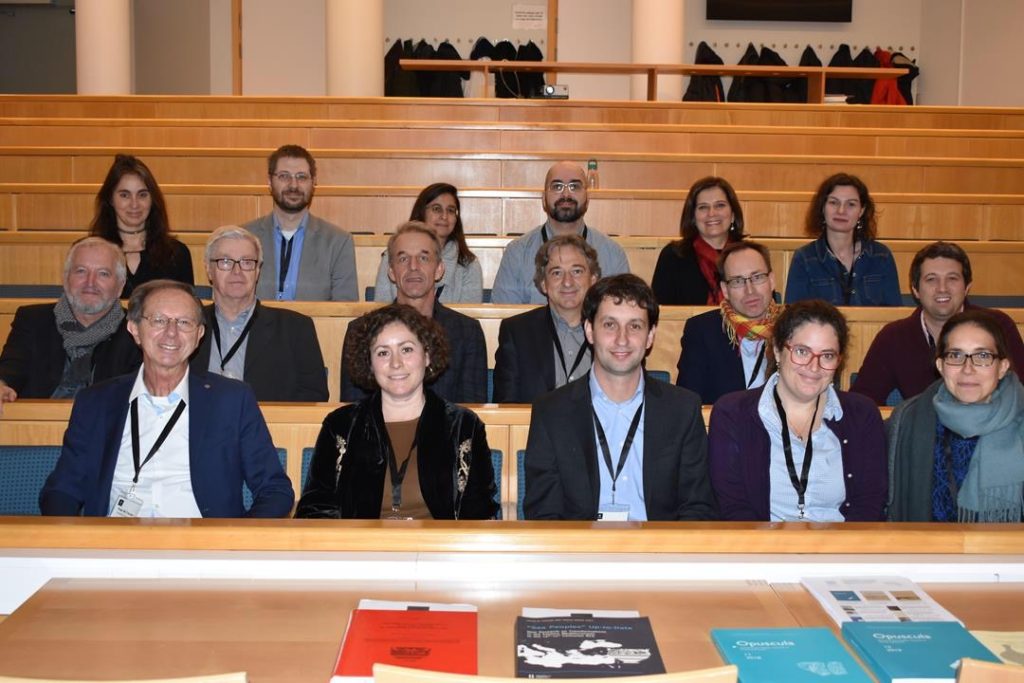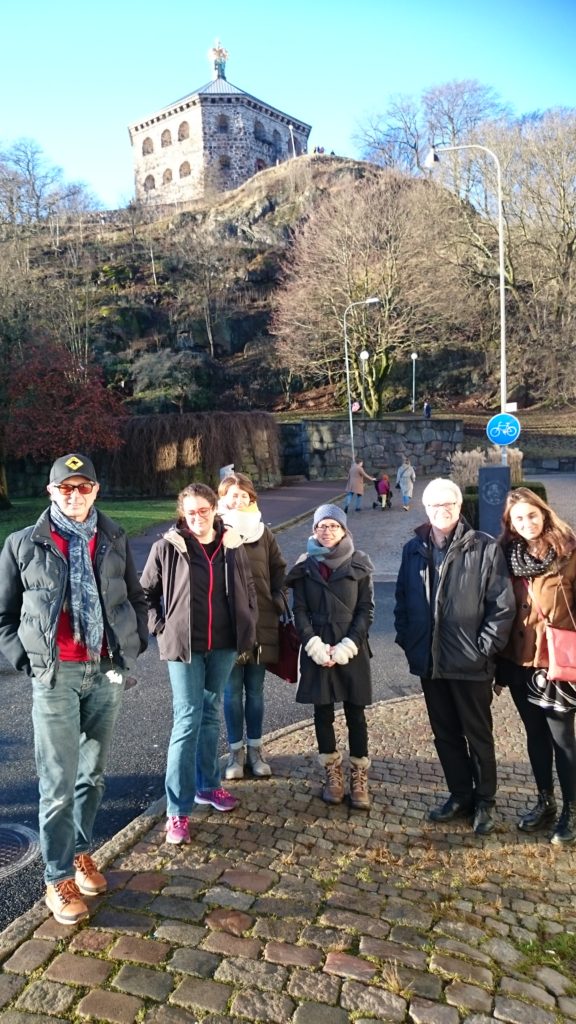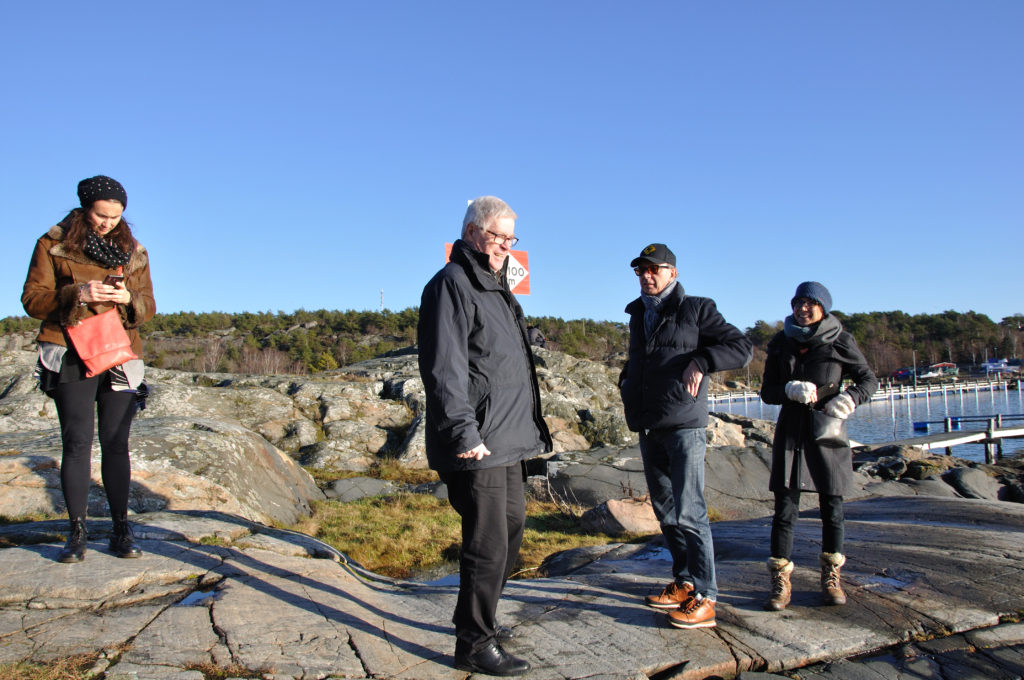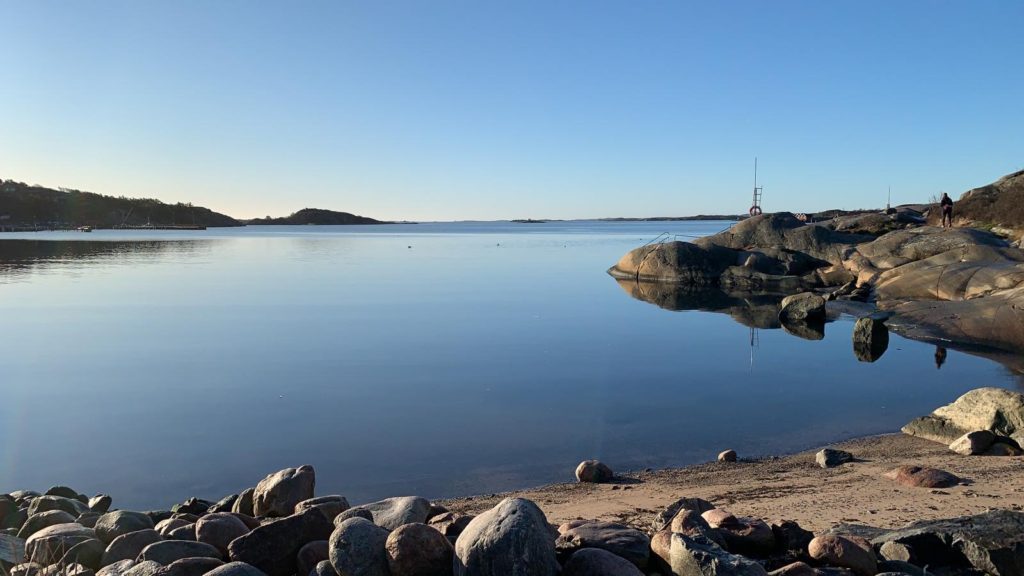See pictures at the bottom of this page!
The Decline of Bronze Age Civilisations
in the Mediterranean:
Cyprus and Beyond
Convened by P.M. Fischer and T. Bürge
Funded by The Swedish Research Council/Vetenskapsrådet grant no. 2019-00327
and
The Riksbank’s Anniverary Fund grant no. F19-1036:1
Date: 17-18 January 2020
Location: Lilla Hörsalen, Humanisten, University of Gothenburg, Sweden
Address: Renströmsgatan 6, 412 55 Gothenburg
Free admission, no conference fees! However, if you intend to visit the conference please inform Teresa.Buerge@oeaw.ac.at (or peter@fischerarchaeology.se).
Programme
17 January
| 08:00 – 09:00 | Registration |
| 09:00 – 09:10 | Welcome by the Head of the Department Henrik Janson |
| 09:10 – 12:30 | Session 1 |
| 09:10 – 09:50 | The end of the Late Bronze Age in the Eastern Mediterranean (Peter M. Fischer, University of Gothenburg) |
| 09:50 – 10:30 | The role of destruction in conflict and collapse: A view from Cyprus and the Levant in the Late Bronze Age (Igor Kreimerman, Heidelberg University) |
| 10:30 – 11:00 | Coffee break |
| 11:00 – 11:40 | The destruction of the Palace of Knossos and Cretan collapse (Jan Driessen, University of Louvain) |
| 11:40 – 12:20 | The Levant and Cyprus at the twilight of the Late Bronze Age: A new synthesis informed by the texts found in the House of Urtēnu at Ugarit (Carole Roche-Hawley, Centre national de la recherche scientifique, Paris) |
| 12:20 – 13:30 | Lunch break |
| 13:30 – 16:40 | Session 2 |
| 13:30 – 14:10 | Results of the excavation seasons 2014–2019 at Pyla-Kokkinokremos, Cyprus: A short-lived settlement at the end of the Bronze Age (Joachim Bretschneider, University of Ghent; Jan Driessen, University of Louvain; Athanasia Kanta, Mediterranean Archaeological Society) |
| 14:10 – 14:50 | Integrating sciences and technologies at Pyla-Kokkinokremos (Sorin Hermon, The Cyprus Institute, Nicosia; Joachim Bretschneider, University of Ghent; Jan Driessen, University of Louvain; Athanasia Kanta, Mediterranean Archaeological Society) |
| 14:50 – 15:20 | Coffee break |
| 15:20 – 16:00 | Cypriot copper production, consumption and trade in the 12th century BC (Vasiliki Kassianidou, University of Cyprus) |
| 16:00 – 16:40 | Bronze Age copper production at Hala Sultan Tekke: First archaeometallurgical results (Mathias Mehofer, University of Vienna) |
| 18:30 – 21:00 | Speakers’ dinner at the Ågrenska Villan |
18 January
| 09:00 – 12:50 | Session 3 |
| 09:00 – 09:40 | 14C-dating of the Late Bronze Age city of Hala Sultan Tekke (Eva Maria Wild, University of Vienna; Peter M. Fischer, University of Gothenburg; Peter Steier, University of Vienna; Teresa Bürge, Austrian Academy of Sciences) |
| 09:40 – 10:20 | The LC IIC to IIIA transition at Hala Sultan Tekke: A pottery perspective (Teresa Bürge, Austrian Academy of Sciences) |
| 10:20 – 11:00 | Neutron Activation Analysis of the pottery corpus of Hala Sultan Tekke and comparison to literature data (Johannes H. Sterba, TU Wien) |
| 11:00 – 11:30 | Coffee break |
| 11:30 – 12:10 | Provenance analysis of ceramics and stone anchors from Hala Sultan-Tekke: Evidence for intra-island and interregional trade connections during the Late Bronze Age (Paula Waiman-Barak, University of Haifa) |
| 12:10 – 12:50 | The external contacts of Cyprus in the Late Bronze Age (Reinhard Jung, Austrian Academy of Sciences; Hans Mommsen, University of Bonn; Tatiana Pedrazzi, Consiglio Nazionale delle Ricerche) |
| 12:50 – 14:00 | Lunch break |
| 14:00 – 17:10 | Session 4 |
| 14:00 – 14:40 | Cypriot pottery in Anatolia in the Late Bronze Age (Ekin Kozal, University of Freiburg) |
| 14:40 – 15:20 | Trade networks, food storage, and the response to the crisis of LBA societies: An analysis of the Levantine storage and transport containers in the 13th–11th centuries BCE (Tatiana Pedrazzi, Consiglio Nazionale delle Ricerche) |
| 15:20 – 15:50 | Coffee break |
| 15:50 – 16:30 | Animals at the decline of the Late Bronze Age in Cyprus and beyond (Laerke Recht, University of Cambridge) |
| 16:30 – 17:10 | When Cyprus turned cold: A view from the past 6000 years (David Kaniewski, Université de Toulouse, CNRS; Nick Marriner, Université de Franche-Comté; Rachid Cheddadi, Université Montpellier II; Christophe Morhange, Aix Marseille Université) |
| 17:10 – 18:30 | Closing discussion, proceedings, future activities |
| 19:30/20:00 – | Speakers’ dinner at a local restaurant |
Abstracts
The end of the Late Bronze Age in the Eastern Mediterranean
Peter M. Fischer, University of Gothenburg
In the past, the end of the Bronze Age in the Eastern Mediterranean – at that time dated mainly to the first half of the 12th century BCE – has been described as a period dominated by the mysterious migrating, attacking and wrecking Sea Peoples. Recent research based on new excavations and advanced scientific methods has demonstrated that this simplistic view explaining the collapse of the advanced Bronze Age societies needs to be modified. This became particularly true during the latest, general, conference on the “Sea Peoples” held at the Austrian Academy of Sciences in Vienna 2014 (published by Fischer & Bürge in 2017) which confirmed that the collapse of the Bronze Age cultures was a complex phenomenon which affected various societies differently and not always simultaneously. In order to merge earlier and current research the term “Sea Peoples phenomenon” for these years of a general crisis was accepted by the majority of participating scholars.
The axiom “chronology is the backbone of archaeology” touches upon a major problem as the dating of this period with radiocarbon is concerned. Unfortunately, the calibration curve especially from the last quarter of the 13th until the last quarter of the 12th century shows a calibration plateau which makes radiocarbon dating of crucial contexts within narrow time intervals impossible – unless the much debated and partly rejected Bayesian statistics are used. There are, though, a limited number of written sources which mention attacks by seaborn people but also land troops, for instance, from the House of Urtēnu at Ugarit and the period of the reigns of the Egyptian pharaohs Ramesses II, Merneptah and Ramesses III, i.e. roughly the 13th until the first quarter of the 12th centuries BCE. To some extent, these documents allow more precise dates but they also demonstrate that numerous troublesome events took place over quite a long period.
The situation in Cyprus, especially from Late Cypriot IIC2 to IIIB1, i.e. approximately the second half of the 13th to the end of the 12th centuries BCE, can serve as a mirror of these events. Several major sites, which flourished in the 13th century, suffered from destructions around 1200 BCE. Some were abandoned others survived into Late Cypriot IIIA before they were abandoned, and a few were still occupied in Late Cypriot IIIB. Valuable contributions to resolve the Sea Peoples phenomenon come from the ongoing field work at the key sites of Hala Sultan Tekke on the south-east coast which has a lifespan of approximately 500 years, i.e. 1650–1150 BCE, and – 16 km to the north-east – the short-lived site of Pyla-Kokkinokremos with a lifespan of approximately 50 years in Late Cypriot IIC/IIIA.
This paper will present an overview over the situation in the Eastern Mediterranean during years of a general crisis with a special focus on Cyprus and Hala Sultan Tekke.
The role of destruction in conflict and collapse: A view from Cyprus and the Levant in the Late Bronze Age
Igor Kreimerman, Heidelberg University
Destruction layers – usually represented by structures covered with burnt mud bricks, ash, charcoal and broken pottery – are among the most visible archaeological markers of Late Bronze Age collapse in the Eastern Mediterranean. But why were so many sites destroyed and what role did destruction play in the collapse process?
The paper will present a new interpretational framework for understanding destruction by fire. First, the materiality of destruction will be briefly examined on the basis of experimental burning of mud-brick structures and insights from modern fire investigation. It would be argued that destruction required knowledge, planning and an investment of effort so when evidence of destruction is wide-spread, destruction most-probably was human induced.
Next, a survey of ancient Near Eastern literary sources will highlight the considerations taken when the fate of a conquered city was determined. Finally, the archaeological evidence for key destruction layers in Cyprus and the Levant would be re-evaluated in the light of the above framework to offer a new understanding of the processes and power struggles that took place in the 13th and early 12th centuries BCE.
The end of the Mycenaean Period: Collapse, decline or a bit of both
Helène Whittaker, University of Gothenburg
Around 1200 BC over a period of time which may have been as long as a quarter of a century all of the major centres of power on the Greek mainland were destroyed. The palaces were not rebuilt and their destruction is therefore generally thought to have had wide-reaching political effects in that it brought about the collapse of several centuries of palatial rule. The transition then from the thirteenth to the twelfth century can be regarded as a turning point with a definite before and after. However, as argued in the papers in Questioning Collapse. Human Resilience, Ecological Vulnerability, and the Aftermath of Empire (2010, edited by Patricia Ann McAnany and Norman Yoffee), although societies may suffer wide-reaching political collapses, these are rarely total in the sense that the entire social and cultural framework falls apart and there may be significant elements of continuity. On the Greek mainland the effects of the destruction of the palaces do not seem to have been the same in all regions. In this paper I will explore the meaning of the terms collapse and continuity in relation to the evidence from the Greek mainland in the period after the destruction of the palaces.
The destruction of the Palace of Knossos and Cretan collapse
Jan Driessen, University of Louvain
The Late Bronze Age history of Crete is one of turmoil. Ceramic deposits suggest that the palace of Knossos suffered on several occasions before its final abandonment late in the 13th c. BCE. The same is true when looking at the Cretan countryside. After the LM IB destructions, some sites are rapidly reoccupied, others only at a later stage, while others are abandoned. New settlements also appear, however. Moreover, site histories differ considerably as do regional settlement trajectories. While material culture as such often connects with earlier Minoan traditions, several new practices appear, not in the least in the funerary domain.
The earliest post-LM IB phases can, without much hesitation, be labelled ‘Knossian’, while the later ones cannot. The change happens during the Late Minoan IIIA2 period, probably in the second half of the 14th c. BCE. The main (but not only) destruction of Knossos had a major impact on the further history of the island but also on the rest of the Aegean. Thus far, the destruction of Knossos has either been blamed on internal strife or on the side of a Mycenaean kingdom or on a coalition of these. This paper reconsiders some of the evidence for Cretan site destruction and abandonment and discusses the various hypotheses with regard to the cause of the destructions, also leaving the possibility open of a potential unknown third party like the Shardana, one of the groups later counted amongst the Sea People, who make their first appearance in the Amarna letters (c. 1350–1330 BCE).
The Levant and Cyprus at the twilight of the Late Bronze Age: A new synthesis informed by the texts found in the House of Urtēnu at Ugarit
Carole Roche-Hawley, Centre national de la recherche scientifique, Paris
The texts found in the “House of Urtēnu” in Ugarit shed new light on the end of the Late Bronze Age on the Mediterranean coast just prior to the so-called “invasion of the Sea Peoples”. These texts, published as well as unpublished, illustrate the dynamics of the commercial and scribal relationships between the main powers (Egypt, Assyria and Hatti), but also with the ports of “Phoenicia” and Cyprus.
This paper focuses on Alašiya and the role it played in the Eastern Mediterranean at the twilight of the Late Bronze Age. In particular, we will examine the relationship between Sidon and Cyprus, both of which show comparable but distinct scribal links with Assyria.
Results of the excavation seasons 2014–2019 at Pyla-Kokkinokremos, Cyprus: A short-lived settlement at the end of the Bronze Age
Joachim Bretschneider, University of Ghent; Jan Driessen, University of Louvain; Athanasia Kanta, Mediterranean Archaeological Society
Since its discovery in the early 1950s, the Late Bronze Age settlement of Pyla-Kokkinokremos has occupied a prominent position in the debates surrounding the ‘collapse’ of Bronze Age Mediterranean societies c. 1200 BCE. Several elements contributed to the site’s particular status in the Late Cypriot IIC–IIIA settlement landscape: the short-lived character of the site – founded towards the end of the 13th c. BCE and abandoned during the first quarter of the 12th c. BCE, its exceptional ‘casemate’ architecture, and its multi-ethnic material culture – with references to Sardinia, Crete, Egypt, Anatolia, the Syro-Palestinian coast and Mycenaean Greece.
In 2014, J. Bretschneider, J. Driessen and A. Kanta inaugurated a new excavation project at Pyla-Kokkinokremos following previous successful investigations by P. Dikaios, V. Karageorghis and A. Kanta. The lecture will focus on the results of the excavation campaigns since 2014.
Integrating sciences and technologies at Pyla-Kokkinokremos
Sorin Hermon, The Cyprus Institute, Nicosia; Joachim Bretschneider, University of Ghent; Jan Driessen, University of Louvain; Athanasia Kanta, Mediterranean Archaeological Society
The report will present the contribution of integrated science and technologies approaches to the study of architectural remains and of selected artefacts, most of them being unearthed during recent excavation seasons of the C-PEPL project and in collaboration with The Cyprus Institute. Since 2015 the Institute participates to the geodesic surveying, 3D terrestrial and airborne documentation of architectural remains of the site, and conducts non-invasive and non-destructive chemico-physical investigations, technical imaging and 3D shape analysis on selected artefacts, in order to characterise their materiality and understand their mode of production, technique of manufacture, possible uses and provenance. We will present our 3D field documentation methodology and preliminary results based on scientific visualisation and virtual reconstruction methods, as well as results of in-depth investigation of selected artefacts, such as a gold bar, a bronze figurine, an unknown stone object, alabaster vessel, and so forth. Preliminary results show a recurrent pattern in the special finds repertoire, where heterogeneous high-quality objects, brought probably from elsewhere, were on-site modified to be later on hidden prior to an apparent attack or hasty abandonment, but with the hope of a return that never occurred. The architectural remains investigation indicate a well-planned settlement, with a range of specific functions buildings extending over substantial parts of the plateau.
Cypriot copper production, consumption and trade in the 12th century BC
Vasiliki Kassianidou, University of Cyprus
Although the production and small-scale trade of Cypriot copper begin already from the middle of the third millennium and expand in the first half of the second millennium, it is in the centuries that follow, namely during the Late Cypriot, that they reach a peak. The archaeological evidence both from the island and overseas are abundant. They indicate that the 13th century is actually the zenith of the copper industry with copper workshops active in most excavated sites. One of the most important sites is undoubtedly that of Apliki Karamallos, a modest miner’s village, which was established and occupied during the 13th century but was abandoned by the 12th century. The mine Apliki has been found to be the most probable source for the copper traded all over the Mediterranean and beyond in the form of oxhide ingots. The other important site is of course Enkomi where Dikaios’ excavations brought to light workshops active, already from the earliest phases of occupation at the site, which expand considerably in the 13th century. What, however, happens to copper production in the 12th century, a time of great changes in all aspects of life and culture on the island? The aim of this paper is to investigate the changes in Cypriot copper production, consumption and trade in this century.
Bronze Age copper production at Hala Sultan Tekke: First archaeometallurgical results
Mathias Mehofer, University of Vienna
Within an ongoing co-operation project between the Department of Historical Studies, University of Gothenburg and the VIAS, Vienna Institute for archaeological Science, University of Vienna, the archaeometallurgical remains, excavated at Hala Sultan Tekke, are studied. To date more than one ton of slags, vitrified clay, metallurgical ceramics and copper were found in the settlement layers of the site. The slags can be generally divided into two groups. The first comprises tapped slags with a greyish to blackish colour and iron oxides on the surface. Their cross section revealed several layers, gas bubbles and many matte inclusions (Cu/Fe-sulphides), copper metal was not detected. The other slags which can be assigned to the second group have a hemispherical to globular form. They have a dark grey colour and are covered with reddish iron oxides. Their surface does not show any signs of tapping. In the cross section one can observe a dense microstructure with matte inclusions and – in contrast to the first group – copper droplets. The archaeometallurgical examinations (OM, SEM-EDS, XRF, LIA) of the metals and slags will focus on the reconstruction of the smelting processes carried out at Hala Sultan Tekke as well as on the comparison of the analytical results with already published analyses from other copper production sites like Aplíki-Karamállos, Kalawassós-Ájios Dhimítrios, Enkomi and Kition.
14C-dating of the Late Bronze Age city of Hala Sultan Tekke
Eva Maria Wild, University of Vienna; Peter M. Fischer, University of Gothenburg; Peter Steier, University of Vienna; Teresa Bürge, Austrian Academy of Sciences
Hala Sultan Tekke (HST) is an archaeological key site in the Late Bronze Age Eastern Mediterranean. The city is located on the south-eastern littoral of Cyprus along today’s isolated Larnaca Salt Lake which earlier was connected to the Mediterranean Sea. Owing to the best protected harbour on the island the city became one of the most important and wealthiest trading centres at that time. This is indicated by archaeological finds originating from a vast area, which includes most of the Mediterranean comprising Italy, the Aegean, Anatolia, the Levant and even southern Scandinavia. According to archaeological evidence the Late Bronze Age city was occupied for several centuries until its final destruction in the 12th century BC. Given the importance of the site and its interaction with other Late Bronze Age sites the dating of the occupation periods of HST is of major importance and 14C dating plays an essential role to verify the chronology based on archaeological finds. Thus, in the course of the current excavation several samples from various locations in the excavation area were 14C dated with the AMS (accelerator mass spectrometry) method at the VERA-laboratory. Whenever possible we used short lived terrestrial plant material for dating in order to avoid any material inherent age offsets. If only charcoals were available the samples were inspected by a dendrochronologist and material where a negligible “old wood” effect can be expected was preferentially selected for 14C determinations. Up to now we obtained ~25 new 14C dates in the ongoing project. These dates add to an already existing data set and the long-term objective is to establish a Bayesian model to pin down the time ranges determined for the individual occupation periods of the Hala Sultan Tekke site.
The current state of the 14C investigations will be reported in this paper.
The LC IIC to IIIA transition at Hala Sultan Tekke: A pottery perspective
Teresa Bürge, Austrian Academy of Sciences
After almost 50 years of research at the Late Cypriot harbour town of Hala Sultan Tekke, the LC IIC to IIIA transition, i.e. the period around 1200 BCE, has become manifest only in the most recent excavation campaigns, since well-stratified material from settlement contexts was largely missing. In addition to the well-known abandonment of Cypriot tableware, such as White Slip and Base-ring, and the increasing adoption and local production of Aegean pottery in this period, plain and cooking wares display marked changes and innovations in technology, choice of material and shapes. Besides an attempt to characterise the transition from LC IIC to IIIA from a pottery perspective, the paper will discuss changes and continuities in internal and external relations of Hala Sultan Tekke.
Neutron Activation Analysis of the pottery corpus of Hala Sultan Tekke and comparison to literature data
Johannes H. Sterba, TU Wien
A total of 334 ceramic samples from Hala Sultan Tekke were analyzed by Neutron Activation Analysis (NAA) at the Atominstitut in Vienna for their chemical fingerprint. Applying multivariate statistical methods, including the best relative fit factor as developed in Bonn in the 1980, the samples were iteratively grouped according to their bulk chemical composition. This grouping led to more than 15 groups of varying size (from 2 to over 30 samples) that mostly correlate with the archaeological grouping.
Comparison to literature was done by applying an interlaboratory calibration factor to the measured dataset. Several local and distant chemical fingerprints already published could be found in the dataset, including samples from the Mycenae/Berbati and the Tiryns/Asine groups as established by Mommsen.
Provenance analysis of ceramics and stone anchors from Hala Sultan-Tekke: Evidence for intra-island and interregional trade connections during the Late Bronze Age
Paula Waiman-Barak, University of Haifa
Provenance analysis of 300 ceramic vessels and 14 stone anchors found in the harbour site of Hala Sultan-Tekke was conducted to investigate trade systems of Late Bronze Age societies. The analytic methods include petrography and FTIR of artefacts and raw materials collected around the island that provided comparable data used for the identification of production centres.
Our choice of assemblages and analytical method enabled us to identify the ceramics locally produced on site which include all forms of White Painted Wheel-made, Plain White Wheel-made wares, Bucchero jugs and White-Shaved juglets. Other specialized wares such as cooking pots, White-Slip, Base-Ring and possibly Red Lustrous Wheel-Made spindle bottles and platters were transported to the harbour from elsewhere in the Island. The flow of ceramics to Cyprus included abundant imports shipped from the Aegean, Sardinia, the Levant and Egypt.
The analysis of stone anchors shows that most analysed anchors are made of limestone or chalk that could have been obtained from quarries either in the close vicinity of Hala Sultan-Tekke or elsewhere. One exception in this assemblage is an anchor made of greywacke, a metamorphic rock foreign to the local environment. The results of this study provide a framework for elucidating direct and indirect exchange of goods and allow for a better understanding connectivity between Late Bronze Age societies revealed not only in the durable goods but also in perishables invisible to the archaeological record, as well as the movement of information and ideas.
The external contacts of Cyprus in the Late Bronze Age
Reinhard Jung, Austrian Academy of Sciences; Hans Mommsen, University of Bonn; Tatiana Pedrazzi, Consiglio Nazionale delle Ricerche
Ongoing research is producing an increasingly detailed picture on the external relationships of the eastern Mediterranean island of Cyprus – contacts the range of which has been recognized as long ago as the majority of the widely distributed oxhide ingots are proven to contain Cypriot copper. For any approach to achieve a regionally and chronologically differentiated picture, it is essential to combine a fine-grained typological analysis, a strictly stratigraphic contextualization (both on site-level as well as in inter-regional comparison) and a precise provenance analysis based on archaeometric methods. Only in this way, one may hope to disentangle imports from specific regions and selective stylistic adaptations and to use these data in a holistic historical reconstruction.
We will provide new evidence from three LC settlements, Maa-Palaeókastro, Pyla-Kokkinókremos and Enkomi while referring to NAA results on different pottery classes with a special focus on Aegean-type and Aegeanizing pottery as well as on Syro-Palestinian amphorae (Canaanite jars).
Cypriot pottery in Anatolia in the Late Bronze Age
Ekin Kozal, University of Freiburg
This paper deals in general about the Cypriot pottery in Anatolia, which reflects only one side of Cypro-Anatolian connections in the Late Bronze Age. Prior to the Late Bronze Age Cypriot pottery appears occasionally in the Early and Middle Bronze Ages in Cilicia and in Kültepe respectively in Anatolia. Late Bronze Age is a vivid period in terms of interconnections, when various Cypriot wares were found at different sites throughout Anatolia. Although the pottery is not the material of primary importance from Cyprus, as it is gathered from the written evidence, it still provides significant information. First of all, it demonstrates the communications between different regions of Anatolia and Cyprus throughout the Late Bronze Age. The general distribution of Cypriot pottery can also be used to reconstruct the trade routes used for the imported pottery. Secondly, contextual information gives hints about the social/administrative structures behind the networks. Thirdly, the pottery types indicate the function of the traded vessels. Conclusively, not only varied features of Late Cypriot pottery in Anatolia will be discussed in detail but also an overall analysis will also be presented.
Trade networks, food storage, and the response to the crisis of LBA societies: An analysis of the Levantine storage and transport containers in the 13th–11th centuries BCE
Tatiana Pedrazzi, Consiglio Nazionale delle Ricerche
Through the analysis of the circulation of transport and storage containers (Canaanite jars and some types of pithos) between the 13th and 11th century, it is possible to contribute to reflect on the nature of the crisis incurred by Late Bronze societies, including the responses (or reactions) to the crisis itself. The dynamics of creation and maintenance of commercial circuits, between the Late Bronze and Early Iron ages, allow us also to understand more deeply the phenomenon of Sea Peoples. In the social sphere, “network studies”, with attention to some key concepts such as centrality and connectivity, have become widespread over the last decade. Therefore, in order to give an updated overview of the socio-economic framework during the crisis (and post-crisis) years in the Eastern Mediterranean, the processes of creating and maintaining commercial networks must be analysed through an integrated approach, taking into account economic, social and (possibly) also cognitive aspects. This paper will try to offer some insights on a study of Canaanite jars and big size pithoi following this methodological perspective. Specifically, the morphological and functional differences of the various types of storage container circulating between Cyprus and the Levantine coast will be presented; the evolution and transformation of the distribution network of these vessels will be discussed in a diachronic perspective (13th–11th c.); and, finally, an attempt will be made to evaluate the contribution offered by Canaanite jars and pithoi to the reconstruction of the specific degrees of connectivity in the Eastern Mediterranean between the LBA and EIA.
Animals at the decline of the Late Bronze Age in Cyprus and beyond
Laerke Recht, University of Cambridge
This paper will explore the faunal and iconographic record at the end of the Bronze Age in Cyprus to understand which animals were present and how they featured in social structures and transformations. Animals feature prominently in the main aspects of human life: wild and domestic species are broadly consumed, and consumption strategies strongly influence lifestyles; secondary products are part of or the result of production; certain species are central to ideological and religious concerns; and animals were extremely mobile both in terms of trade and as moving (with) people.
Therefore, an examination of the animal dimension will help our understanding of how people lived and related to their broader environment in the past. The focus will be on animals with a strong presence on Cyprus and what they reveal about the island and its wider relations at this crucial time. In particular, the species of cattle, equids and birds will be discussed. Although not the most dominant in the faunal assemblages, they are especially popular in the iconography and may reflect contemporary ideologies as well as intensive and extensive contact with other regions of the Eastern Mediterranean. A degree of shared iconographic references can be detected that attests to the ‘internationalism’ of the period, while Cyprus adapts these to fits its own needs and tradition.
When Cyprus turned cold: A view from the past 6000 years
David Kaniewski, Université de Toulouse, CNRS; Nick Marriner, Université de Franche-Comté; Rachid Cheddadi, Université Montpellier II; Christophe Morhange, Aix Marseille Université
In 2016, a new drilling campaign was undertaken on the Larnaca Salt Lake under the auspices of the Swedish team led by P.M. Fischer. Three long cores were retrieved from the lacustrine sediments close to the Hala Sultan Tekke archaeological site. One of the cores, HST1, was provided a good record of Holocene environmental change since the mid-Holocene. The core’s chronology is based on 15 radiocarbon dates. The age model constrains the chronology of the core to 5745±20 cal yr BP at the bottom and 515±50 cal yr BP for the upper part. An environmental study (pollen grains, charcoal remains, and seeds) was first undertaken to probe the long-term ecosystem dynamics in this coastal area. A pollen-based climate model was then calculated to reconstruct the evolution of temperatures and precipitation during the last 6000 years. The sequence records five well-known climate events in the Mediterranean: the 5.2, 4.2 and 3.2 ka BP events in addition to the Late Antiquity Little Ice Age and the onset of the pre-industrial Little Ice Age. All of these events were characterized by a drop in temperatures and a fall in rainfall amounts during the sowing and growing seasons of crops (winter and spring). These cooler and drier periods seem to have had an impact on crop yields, reducing the harvests and potentially affecting local societies.

Gothenbuirg Conference participants 17 January 2020

Visiting Gothenburg city centre 19 January 2020

Gothenburg coast 19 January 2020

Gothenburg Kattegatt Sea 19 January 2020
Contact: Teresa.Buerge@oeaw.ac.at; peter@fischerarchaeology.se

